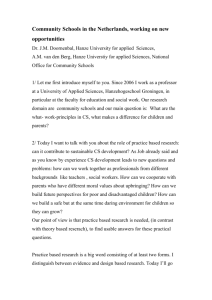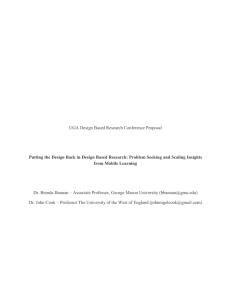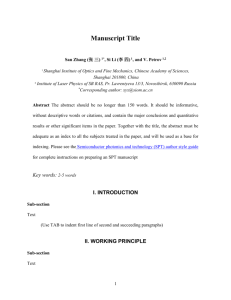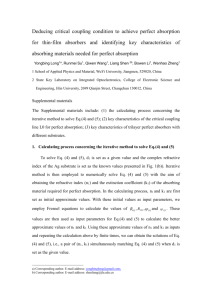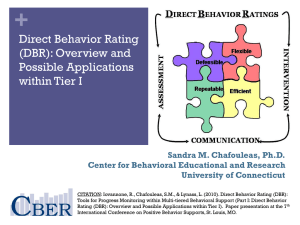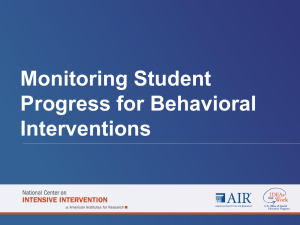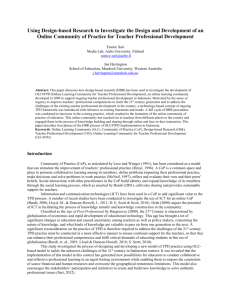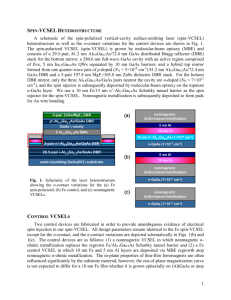Design-Based research final submitted
advertisement
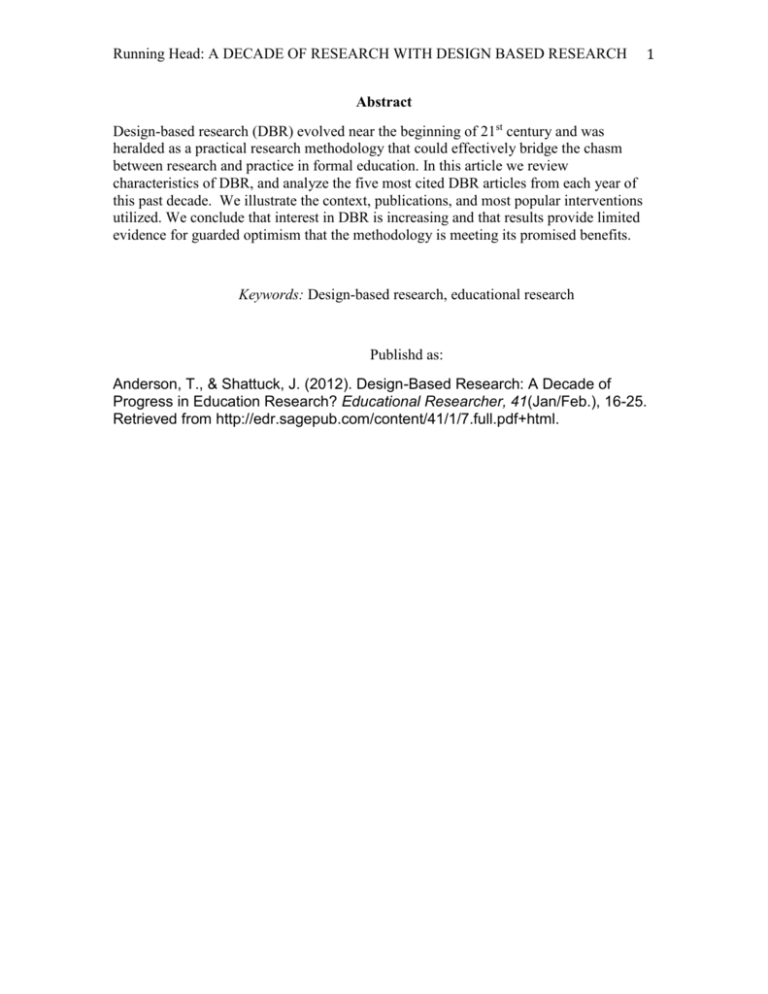
Running Head: A DECADE OF RESEARCH WITH DESIGN BASED RESEARCH 1 Abstract Design-based research (DBR) evolved near the beginning of 21st century and was heralded as a practical research methodology that could effectively bridge the chasm between research and practice in formal education. In this article we review characteristics of DBR, and analyze the five most cited DBR articles from each year of this past decade. We illustrate the context, publications, and most popular interventions utilized. We conclude that interest in DBR is increasing and that results provide limited evidence for guarded optimism that the methodology is meeting its promised benefits. Keywords: Design-based research, educational research Publishd as: Anderson, T., & Shattuck, J. (2012). Design-Based Research: A Decade of Progress in Education Research? Educational Researcher, 41(Jan/Feb.), 16-25. Retrieved from http://edr.sagepub.com/content/41/1/7.full.pdf+html. Running Head: A DECADE OF RESEARCH WITH DESIGN BASED RESEARCH 2 Design-Based Research: A Decade of Progress in Education Research? The first decade of this century has seen the emergence of a new research methodology for education research - design-based research (DBR). A number of respected educational researchers and special issues of well-known journals have celebrated the potential of DBR to make a significant difference to the quality and utilization of educational research. But has DBR lived up to these expectations? DBR is a methodology designed by and for educators that seeks to increase the impact, transfer, and translation of education research into improved practice. In addition, it stresses the need for theory building and development of design principles that guide, inform, and improve both practice and research in educational contexts. In this paper we review basic features of DBR, describe the trends towards increasing use, and highlight and analyze the most cited articles that focus on DBR in education. We note the challenges researchers deploying the methodology face and speculate on its application in the near future. What is DBR? Descriptions of DBR abound and have even found a home in a short article on Wikipedia, so we will do no more than give a cursory overview of the methodology. We should also note that the terms ‘design-research’ (Oha & Reeves, 2010) and ‘development research’ (Conceicao, Sherry & Gibson, 2004; Oha & Reeves, 2010) have also been used to describe this methodology, but we use the more popular term designbased in this study. For a more in-depth overview, the interested reader is invited to read the articles in the three special issues of education journals published in 2003-4. (Journal of the Learning Sciences, 13(1); Educational Researcher, 32(1); Education Psychologist 39(4). Our own analysis of the original and emerging definitions of methodology suggest a quality DBR study is defined by: Being situated in a real educational context. Being situated in a real educational context provides a sense of validity to the research and insures that the results can be effectively used to assess, inform and improve practice in at least this one (and likely other) contexts. Focussing on the design and testing of a significant intervention. Ann Brown, the American researcher credited with first developing DBR, noted that “an effective intervention should be able to migrate from our experimental classroom to average classrooms operated by and for average students and teachers, supported by realistic technological and personal support” (Brown, 1992). The selection and creation of the intervention is a collaborative task of both researcher(s) and practitioner(s). The creation begins with an accurate assessment of the local context; is informed by relevant literature, theory and practice from other contexts; and is designed specifically to overcome some problem or create an improvement in local practice. The intervention may be a learning activity, a type of assessment, the introduction of an administrative activity (such as a Running Head: A DECADE OF RESEARCH WITH DESIGN BASED RESEARCH 3 change in holidays), or be a technological intervention- to mention just a few of the common types of interventions. The design of these interventions is a key feature of the quality and results of the research project. Mingfong, Yam San, & Ek Ming (2010) have identified four design characteristics that they suggest must be aligned to create effective interventions. These are “frameworks for learning, the affordances of the chosen instructional tools, domain knowledge presentation, and contextual limitations” (Mingfong, Yam San & Ek Ming, 2010). The researcher is careful to document the time, commitment, and contingencies that are involved in the creation and implementation of the intervention. These are documented so that readers of the research can judge for themselves the possibility of achieving similar –or even better results of the use of this intervention in their own context. Use of mixed methods. DBR interventions are assessed on a wide variety of indices using multiple methodologies. DBR is largely agnostic when it comes to epistemological challenges to choice of methodologies used and typically involves mixed methods using a variety of research tools and techniques. Most DBR researchers would concur with Maxcy (2003) who argued “It is perfectly logical for researchers to select and use differing methods, selecting them as they see the need, applying their findings to a reality that is both plural and unknown” (p. 59). Moreover, the choice of methods, and focus on authentic and meaningful issues resonates with pragmatic philosophy and outlook associated with American pragmatism notably Charles Sanders Peirce, John Dewey and William James and later Abraham Kaplan and Richard Rorty. Involving multiple iterations. Design practice – whether in the manufacture of cars or of fashions, usually evolves through the creation and testing of prototypes, iterative refinement and continuous evolution of the design, as it is tested in authentic practice. We often joke in our work that the iterative adjustment and improvement of our interventions could be characterized by “research through mistakes.” Design-based interventions are rarely if ever designed and implemented perfectly, thus there is always room for improvements in the design and subsequent evaluation. This evolution, through multiple iterations is but one of the challenges of the methodology in that it is difficult to know when (or if ever) the research program is completed. Involving a collaborative partnership between research(s) and practitioner(s). In action research the educator is both researcher and teacher (Kuhn & Quigley, 1997). The partnership in a design-based study recognizes that teachers are usually too busy and often ill trained to conduct rigorous research. Likewise, the researcher is often not knowledgeable of the complexities of the culture, technology, objectives, and politics of an operating educational system to effectively create and measure the impact of an intervention. Thus, a partnership is developed that negotiates the study from initial problem identification, through literature review, to intervention design and construction, implementation, assessment, and the creation and publication of theoretical and design principles. Evolution of design-principles. Designs evolve from and lead to development of practical design principles, patterns and/or grounded theorizing. The focus on theoretical Running Head: A DECADE OF RESEARCH WITH DESIGN BASED RESEARCH 4 understanding is implied in the fourth and final phase of DBR study that Reeves (2000) referred to as “reflection to produce design principles and enhance solution implementation” (p. 9). These principles are not designed to create de-contextualized principles or grand theories that function with equal effect in all contexts. Rather, design principles reflect the conditions in which they operate. These tools and conceptual models function to help us understand and adjust both the context and the intervention so as to maximize learning. Dewey (1932) warns that while general ideals and principles are of value in the direction and enlargement of conduct, they are also dangerous: they tend to be set up as fixed things in themselves, apart from reference to any particular case (Dewey, 1932 in Boydston (1971, 7:232). Dewey realized that new meanings, values and attitudes become encultured in schools only when they have become embodied and are sustained within real life contexts. This requirement is both a key strength of DBR and disadvantages those types of research that unilaterally descend for testing in a classroom and then disappear with the researcher once the experiment has been concluded. Comparison to Action Research. The focus on evolution of design principles differentiates DBR from much action research and formative evaluation designs in that “the design is conceived not just to meet local needs, but to advance a theoretical agenda, to uncover, explore, and confirm theoretical relationships” (Barab & Squire, 2004, p. 5). Cobb, Confrey, diSessa, Lehrer & Schauble (2003), in a seminal article on DBR, identified five cross cutting themes that mark and define DBR. The fifth of these themes is that the research is both humble and accountable to the design meaning that “the theory must do real work. General philosophical orientations to educational matters—such as constructivism—are important to educational practice, but they often fail to provide detailed guidance in organizing instruction”(p.10). As an example this differentiation between grand theories and “theories that work” was picked up by Tiberghien, Vince, and Gaidioz (2009) as they derived a theoretical model for DBR, but restricted its dominion to very practical constraints and specific context of physics instruction. Both practitioners and researchers often have trouble differentiating between action research and DBR- likely because they share many epistemological, ontological and methodological underpinnings. In a comparison of the two methods Cole, Purao, Rossi & Sein (2005) found that the defining qualities of both methodologies share a common ‘meta-paradigm’ – pragmatism. They conclude their article by recommending the integration of the two by adding a reflective step to DBR – though we see reflection as being an integral component of all stages of a DBR research. They also suggest the need for action research to add a ‘build’ phase in which theory, artifacts, models and prototype construction results in instantiation, archiving and distribution of action research results. Finally, we repeat that action research is normally carried on by the teacher(s) alone, thus not benefitting from the expertise and energy of a research and design team that characterizes DBR. The practical nature of DBR, obviously places it (like action research) in the camp of applied research. However, following Stokes (1997) and Stappers (2007), we reject the linear model that places basic and applied research at polar opposites. Rather, good science often leads to both very practical outcomes, while contributing to theoretical and Running Head: A DECADE OF RESEARCH WITH DESIGN BASED RESEARCH 5 basic understandings. In many ways DBR is the educational instantiation of Stokes most productive fourth quadrant that maximizes both generalization and insight with the production of practical applications. Practical impact on practice. Reeves (2000) has also noted that the issue of implementation and adoption is of critical importance and one in which educational research in general has had a very poor record. In our own keynote talks we often challenge participants to think of one research result that has made a difference in their educational practice. It is both surprising and depressing how many educators cannot think of a single research output or can only think of trivial outputs that meet this most practical and important outcome of research. One could contrast this with the many results of medical research and the way that treatments and practice have evolved and continue to evolve as result of medical research. This necessity for impact in real education settings was succinctly captured by Barab and Squire (2004) who argued that “design-based research that advances theory but does not demonstrate the value of the design in creating an impact on learning in the local context of study has not adequately justified the value of the theory” (p. 6). Problems with DBR Despite the numerous articles extolling the benefits, there have also been a number of useful critiques- notably Barab and Squire’s (2004) article. They argued that “if a researcher is intimately involved in the conceptualization, design, development, implementation, and re-searching of a pedagogical approach, then ensuring that researchers can make credible and trustworthy assertions is a challenge” (p. 10). This challenge is a familiar one to anthropological and many forms of qualitative research in that none of these methods can or do claim that the researcher’s bias is removed from the research process. Indeed some qualitative proponents argue that the researchers themselves, (with their biases, insights, and deep understanding of the context), are the best research tool. A number of ways have been suggested to minimize this concern in DBR as well as other qualitative methods (Onwuegbuzie & Leech, 2007) and we argue that this inside knowledge adds as much as it detracts from the research validity. Good research demands “skepticism, commitment and detachment” (Norris, 1997) but DBR also requires comradeship, enthusiasm, and a willingness to actively support the intervention. Thus, a certain wisdom is needed to walk this narrow line between objectivity and bias. The personal skill to hold all of these attitudes simultaneously is a challenge and a defining feature of quality DBR. The challenge of bounding the temporal scope of a DBR project is exacerbated by the requirement for multiple iterations. Herrington, McKenney, Reeves, and Oliver (2007) addressed this concern head-on in an article demonstrating ways in which DBR can be used as a basis for a doctoral dissertation over a four year period. We also note a partial solution is for established educational researchers to develop multi-year DBR research agendas that have legitimate space and roles for graduate students to undertake and ‘own’ significant pieces of this larger agenda. Such large-scale agendas are common in the natural and health sciences, but unfortunately educational research has not, except Running Head: A DECADE OF RESEARCH WITH DESIGN BASED RESEARCH 6 in rare circumstances (notably the research led by Chris Dede on the RiverCity project at Harvard University), managed to achieve the financial support or develop the necessary vision and leadership required by such multi-year and multi-facetted research agendas. From this review of characteristics and concerns, we conclude that DBR has a number of significant characteristics that resonate with the calls for educational reform and for improvements in education research. But how has that potential been realized in the past decade? Has DBR been used and, if yes, has it been most effective in particular disciplines/subjects? Does it seem most compatible with the study of one or more of the levels of formal education? Is its use or at least its recognition centered in one country or region or is interest and use a global phenomenon? Is interest and use growing or did it peak with the special issues of the early part of the decade? Finally, are the types of innovation that researchers have studied using DBR small scale, incremental and sustaining or is DBR also useful for creating and measuring disruptive changes (Christensen, Horn & Johnson, 2008). In order to answer these questions we turned to a systematic examination of the research literature. Method In order to find the articles that used or focused upon DBR, we used Harzing’s (2010) open source tool, Publish or Perish, to perform a Google Scholar search of articles in humanities, arts, and social sciences that contained the keywords “designbased research” and “education” (see figure 1 below). Unfortunately, no one as yet have developed or implemented a structured means of describing or coding research articles such that research method is very cleared labeled for semantic search and retrieval. However, Google Scholar was able to identify articles in which the term was mentioned. It is not feasible to review all of the 1,940 articles identified by Google Scholar and so we used a form of a ‘recommender system’ in which the five articles with the highest number of citations in each year of the decade from 2002-2011 were retrieved and examined. We choose to not count book chapters, conference proceedings, or other grey literature in this analysis –even though some of these were cited by other scholars. Our selection criteria focused on choosing the five most cited articles of each year that either explicitly used DBR or focused on the description, critique, or review of DBR methodology. Articles that merely cited a DBR research study were not included. The only year that we were unable to find five articles meeting our criteria was 2002 (two articles were selected). Figure 1. Search Screen from Publish or Perish Running Head: A DECADE OF RESEARCH WITH DESIGN BASED RESEARCH 7 Citation counts have long been used as the one of two primary means of assessing the quality and/or impact of scientific research. The most common resource for citation analysis is Thomson’s ISI’s Web of Knowledge or as it is now called Social Science Citation Index (SSCI); however, any source of citation data can be used. Although SSCI claims coverage of over 11,400 journals it only covers 2929 journals in the social sciences and humanities (Thompson SSCI, June 2010 http://science.thomsonreuters.com/cgi-bin/jrnlst/jlresults.cgi?PC=SS) and many important educational journals are not covered. In addition, Anderson & McConkey (2009) claim that SSCI, as a commercial venture of Thomson/Reuters Publishing, has a pecuniary bias against coverage of open access journals, though they are increasing the number of open access journals cited in recent years. Scopius, owned by Elsevier, has slightly larger coverage of social sciences and humanities than SSCI, but still covers much less scope than Google Scholar. Google Scholar though is certainly not perfect - one of the reasons being the lack of transparency in that Google Scholar does not publish where, how often, and when it searches for scholarly articles. In an extensive discussion of the advantages and disadvantages of the these three large index services (2010) noted four major advantages of Google Scholar: 1) it is free; 2) it is easy to use; 3) it is quick; and 4) it is comprehensive in its coverage. Harzing went on to show that none of the three lsystems are without error and that each has particular strengths and weaknesses. A number of studies (the University of Queensland library has a list of recent articles at http://tinyurl.com/5sgpwr) have shown no significant differences in citation rates amongst the subset of journals that are covered by all three systems. Further Harzing (2010) provided evidence of strong correlations between citation ratings of Google Scholar, Thompson SSCI, and Scopius. Finally, education (the focus of this review) has always placed premium value on access to both scholarly and educational resources. Harzing and van der Wal (2008) argued that “the free availability of GS allows for a democratization of citation analysis as it provides every academic access to citation data regardless of their institution’s financial means” (p.71). Data from the 47 articles selected (five articles each from 2003-2011 and two articles from 2002) were entered into a spreadsheet with the graphs, tables, and analysis Running Head: A DECADE OF RESEARCH WITH DESIGN BASED RESEARCH 8 presented in the following sections deriving from this compilation. The spreadsheet is available for further analysis (and reader comments) on the WWW at . Results Figure 2. Number of articles using or discussing DBR Number of DB Scholarly Articles Published 400 350 300 250 200 150 100 50 0 2000 01 02 03 04 05 06 07 08 09 10 Figure 2. shows the continuing interest and growth of research articles about DBR. As previously mentioned in the method section, it was not feasible to attempt a review of such a large body or work, so we selected 47 articles from 2002-2011 that met our criteria. The 47 articles included in our database were of two distinct types. Sixteen (34%) were philosophical or expository articles about DBR itself (of these 16 articles, six of them described one or more DBR projects in detail to illustrate DBR in action). These articles often had a proselytizing nature, as could be expected from proponents of DBR trumpeting its (claimed) potential to significantly improve the quality and most important the impact of research in real educational contexts. The 31 remaining articles (66%) provided empirical evidence and results of DBR based research studies. Not surprisingly for an emerging research framework, 88% (14 out of 16) of the philosophical or expository articles about DBR were written in 2002-2006 with 74% (23 out of 31) of the empirical studies occurring in the second half of the decade, 2007-2011. This data suggests the design is moving from theoretical discussion to practice. The research tools employed in the empirical DBR studies were primary mixed with results of both qualitative and quantitative measurements presented. For example: “This paper reports multiple methods as a part of a larger design-based research project” (Klopfer & Squire, 2008, p. 209). “In this section, we will first present two brief qualitative analyses of two GS [GroupScribbles] lessons and motivate how the pedagogical design of the GS activity is enacted with good teacher facilitation. Next, we present some Running Head: A DECADE OF RESEARCH WITH DESIGN BASED RESEARCH 9 quantitative analysis of data which shows positive gains for GS classes compared with non-GS classes” (Looi, Chen, & Ng, 2010, p.18). “The quantitative and qualitative methods used in this study complement each other. While the quantitative method revealed broad patterns of design based discourse, the qualitative method facilitated local clarification through observation, description and interpretation of the features of interactions and the role of the faculty, students, and tasks” (Koehler, Mishra, & Yahya, 2007, p. 750). There was no meta-analysis which is not surprising given that the studies generally lacked control group comparisons, in line with DBR philosophy. There was also no “qualitative meta-analysis” (Timulak, 2009) which may be a promising area for further research, but is also problematic for DBR aggregation given the mixed methodologies often employed. Geographic focus. Figure 3 shows the predominance of publications using DBR originating in the USA (we used the country affiliated with the first-stated author to indicate country of origin; however, six studies were written by authors from more than one country). This is perhaps understandable given the major original development work on DBR and the host country of the major special issues of journal was the USA. Anderson (2005) argues that the practical nature of this methodology resonates with the pragmatic tradition of American educational philosophy originating with Dewey and James. Figure 3. Pie Chart of First-Stated Authors’ Country of Work (n=47) Running Head: A DECADE OF RESEARCH WITH DESIGN BASED RESEARCH 10 Canada 2% Cyprus 2% Germany 2% Israel Netherlands 2% 5% Norway 2% Singapore 4% Swedan 2% Taiwan 2% UK 4% US 73% Discipline and curricular focus. All of the studies reviewed were conducted in educational contexts and primarily published in educational research or discipline-related journals (see Figure 4). Figure 4. Scholarly Publication Outlets for DBR Studies (n=47) Written Communication The Journal of Educational Research Teachers College Record Science Education Research and Practice in Technology Enhanced Learning ReCall Mathematical Thinking and Learning Journal of the Learning Sciences Journal of Teacher Education Journal of Science Education and Technology Journal of Research in Science Teaching Journal of Distance Education Journal of Computing in Higher Education International Journal of Mobile Learning and Organisation Educational Technology Research and Development Educational Researcher Computers in Human Behavior Computers & Education British Journal of Educational Technology British Educational Research Journal American Educational Research Journal Running Head: A DECADE OF RESEARCH WITH DESIGN BASED RESEARCH 11 8 7 6 5 4 3 2 1 0 To more clearly differentiate the context of this work, we classified the studies in which DBR was used by the teaching subject (science, math, history, etc.) and by the stated educational sector. In addition to the data from the 31 articles that focused on DBR research studies, we included data from any empirical studies described as examples of DBR in the 16 expository/philosophical articles. Some articles discussed more than one teaching subject, and we included in the data all teaching subjects that Running Head: A DECADE OF RESEARCH WITH DESIGN BASED RESEARCH 12 were identified in the research. Some studies worked with students from more than one educational sector and we included all stated sectors in our data. In addition, some studies clearly stated age group or grade level, while others grouped participants into broad K12 or post secondary categories. This is indicated in Figure 6 by a broad group of K12 for studies that did not specify age or grade, and elementary (grades K-5, ages 5-10), middle (grades 6-8, ages 11-13), and high (grades 9-12, ages 14-18). As most studies occurred in the US, we used the US school system of grades/ages. Figures 5 and 6 show that science is the discipline most studied in DBR and K12 the age group in our top cited articles. Figure 5. Subject/program in which DBR Studies were undertaken (n=45) Vocational 2% Teacher Training 9% Computers 7% CrossCurricula 13% English Language 5% Literacy 4% Mathematics 9% Science 51% Figure 6. Educational Sector of Empirical DBR Studies (n=55) High 13% K12 27% Middle 18% Elementary 16% PostSecondary 26% Running Head: A DECADE OF RESEARCH WITH DESIGN BASED RESEARCH 13 The empirical studies provided rich descriptions of the context, with authors both pointing out the limitations of their studies, and offering suggestions on how their study may be applicable in other contexts. For example: "The results are limited to such social institutions (e.g., universities), non-profit organizations or companies" (Jahnke, 2010, p. 544). Additional studies are needed in a variety of school contexts to explore design strategies for enhancing effective opportunistic collaboration to determine how, and with what success, different teachers might engage students in more flexible and opportunistic arrangements" (Zhang, Scardamalia, Reeve, & Messina, 2009, p. 39). “After the last cycle of fine-tuning, TM is presented herein as a methodology for guiding teacher thinking about the ill-defined problem of designing technologyenhanced learning. TM can be used in teacher education departments to teach preservice teachers how to teach with technology, and thus to develop their ICT– TPCK knowledge; in teacher professional development programs to prepare inservice teachers in the pedagogical uses of technology; by curriculum developers to decide how technology can be infused in the different content domains; and, most importantly, by the teachers themselves to design lessons with technology" (Angeli & Valanides, 2009, p. 160). "The findings from this study contribute to the literature by providing support that spatial thinking can be learned, can be taught formally to all students in an urban middle school, and can be supported by appropriately designed curriculum and geospatial information technologies. This research also informs curriculum developers with design strategies that can be used to promote spatial thinking with diverse urban classroom learners to promote environmental sciences learning with geospatial information technologies that include virtual globe (Google Earth) use and aerial and RS imagery " (Bodzin, 2011, pp. 295-6). Content and intervention. A word analysis of the 47 abstracts gave the top ten content words as research (84 occurrences), design (73), students (67), learning (62), knowledge (44), study (44), science (36), development (34), technology (28), and curriculum (26) (See Table 1). A search of the term “design-based” in the abstracts resulted in 11 articles, “design research” eight articles, “design experiment(s)” five articles, and “design study(ies)” three articles. As can be seen the topics confirm the educational focus of the studies with inclusion of many relevant topics within our discipline. Table 1. Frequency of Key Words in Abstracts of Empirical DBR Studies (n=31) Running Head: A DECADE OF RESEARCH WITH DESIGN BASED RESEARCH 14 90 80 70 60 50 40 30 20 10 0 DBR studies always involve some type of intervention. We clustered and tallied the 31 empirical studies based upon the type of intervention and display the results in Figures 7 and 8. Using a qualitative analysis package (Atlas.ti), we open-coded the interventions described in the abstracts into two main groups: Instructional Method/Model/Strategy and Technological with ten interventions falling into the first coding category and 21 in the second, technological code. We then grouped the two major codes into sub-codes (see Figures 7 and 8 for summary data). Figure 7: Instructional Method/Model/Strategy (n=10) Curriculum Unit 10% Authentic Tasks 20% Scaffolding 10% Learning Progression 20% Integrated Teaching Models 40% Figure 8: Technological or Instructional Design Intervention (n=21) Running Head: A DECADE OF RESEARCH WITH DESIGN BASED RESEARCH 15 Digital Storytelling 5% Technology supported activities 14% Mobile & Positioning 10% Games 19% Use of an educational software package Software 19% Multi-User Virtual Environment 19% Wiki Social Networking 5% 9% Iterations. One of the challenges of DBR studies is that the iterative nature can exceed the resources or the time available to researchers or funding bodies. In Figure 9 we show how many studies indicated that they were describing the exploratory, initial stage of DBR (six studies), that they were part of a multi-iteration project (27 studies), or that they were reporting on the final stage (one study). A variety of terms and time measurements are used in DBR studies to discuss iterations (e.g., year, site, phase, iteration, cycle, phase, case study), so it is challenging to depict a comparison of multiiteration projects. For the multi-iteration projects, we categorized them using the number given for the iteration term used. Figure 9 shows that over half of the DBR projects discussed in the empirical studies focused on projects that had progressed through three or more iterations. The interested reader might also enjoy the blog post by Mike Rook (2010) in which he chronicles 4 iterations of the RiverCity DBR program. Figure 9 Iteration and Phase Sequences (n=34) Running Head: A DECADE OF RESEARCH WITH DESIGN BASED RESEARCH 16 Ongoing 6% Final phase 3% Multicycle/site/phase 9% 7-year/phases 9% 5-year 6% 4-year 9% Preliminary Stage 17% 2year/trials/itera tions/cycles 23% 3-year/case studies/iteration s/cycles/phases 18% Major Results Deriving generalizations about the results from the diverse types and contexts of DBR study is a daunting task. We used a qualitative analysis package to code the 31 abstracts of the empirical studies, with a focus on the results of the intervention. We open-coded the results described in the abstracts into four main groups: potential for improved student learning (seven occurrences); major new understandings about educational outcomes or context (12 occurrences); increased student learning took place (12 occurrences); and improvements in attitude/epistemology/motivation (five occurrences). Some abstracts’ results fell into more than one of these categories. See Figure 10 for summary data). Figure 10. Summary of Results Described in Abstracts (n=36) Running Head: A DECADE OF RESEARCH WITH DESIGN BASED RESEARCH 17 students improved attitude/episte potential for mology/motivat improved ion student learning 14% 20% Increases in student learning 33% new understandings about educational phenomina 33% Unlike quantitative studies most DBR studies do not produce measureable effect sizes that demonstrate “what works.” However, they provided rich descriptions of the context in which the study occurred, the challenges of implementation, the development process involved in creating and administrating the intervention, and the design principles that emerged. An example of such rich descriptions, taken from our database of 47 articles, is the work on the multi-user virtual environment (MUVE): River City (Ketelhut, 2007; Ketelhut, Dede, Clarke, & Nelson, 2010). Both articles presented research on a scientific inquiry-based National Science Foundation funded project focused on infusing scientific inquiry into a standards-based curriculum. Ketelhut’s (2007) exploratory study investigated self-efficacy in 100 seventh-grade students who participated in the River City project, and she highlighted that "this research on self-efficacy was embedded in a larger, ongoing, NSF-funded project that has implemented River City nationwide with nearly 8,000 students since 2000" (2007, p. 101). Ketelhut , Dede, Clarke, and Nelson, (2010) discussed results from approximately 2000 middle school students who were involved in three implementations of the project in 2004-2005. Both articles referred to other research focused on River City and painted a picture of a multi-faceted, ongoing, and complex DBR project. Discussion The most cited articles focusing on DBR in the last decade highlight the following trends in published DBR studies. The majority of the 47 articles had a US primary author; however, in the last four years, 2008-2011, 50% of first-cited authors were not from the US, suggesting that DB is becoming accepted more globally as a popular research methodology. Half of all the empirical studies explored designing learning interventions for science, and 87% of studies focused on K12 student populations. The majority (68%) Running Head: A DECADE OF RESEARCH WITH DESIGN BASED RESEARCH 18 of interventions involved the use of online and mobile technologies, and all studies indicated that they were part of a multi-iteration research project with 18% being in the exploratory cycle, 3% reporting the post-cycle, and the rest falling into the space between initial piloting and final report. As we stated earlier, one of the challenges of DBR is knowing when, if ever, the research project is completed, so it is not surprising to only find one study that focused on the final write-up of the research. However, even that study left the door open for more research and refinement of the outcome of the multiyear project: the ICT-TPCK framework (Information and Communication TechnologiesTechnological Pedagogical Content Knowledge). We do hope that researchers, instructional designers, and practitioners will find the conceptual framework discussed herein useful and applicable in their respective contexts. Any future research efforts that will be undertaken to validate, modify, or improve the framework proposed for the conceptualization, development, and assessment of ICT–TPCK will be important for both research and practice. (Angeli & Valanides, 2009, p. 167) Collins, Joseph, and Bielaczyc (2004) highlighted that DBR projects often produce a large amount of data as they progress through various iterations, and they called for the sharing of data: design experiments often lead to the collection of large amounts of data that go unanalyzed. Hence, it makes sense for the design-research community to establish an infrastructure that would allow researchers at other institutions to analyze the data collected in design studies, in order to address their own questions about learning and teaching. This would require the community to honor such reanalysis of data with the same status as original research and it would require research journals and tenure committees to take such work seriously." (p. 40) Although a number of the 47 articles presented on different stages of the same intervention (e.g., River City: Ketelhut, 2007; Ketelhut, Dede, Clarke, & Nelson, 2010; Quest Atlantis: Barab, Thomas, Dodge, Carteaux, & Tuzun, 2005; Barab, Sadler, Heiselt, Hickey, & Zuiker, 2007a; Barab, Zuiker, Warren, Hickey, Ingram-Goble, Kwon, Kouper, & Herring, 2007b), there was no evidence in our small sample of 47 articles of these type of data pools suggested by Collins et al. being shared amongst diverse research teams. One of the characteristics of a quality DBR study is “a commitment to theory construction and explanation while solving real-world problems” (Reeves, Herrington, & Oliver, 2005, p. 103). Our qualitative analysis of the empirical studies’ abstracts indicated that the studies’ results focused on both what researchers learned to further their knowledge about a phenomenon and what effect the intervention had on student learning and motivation. This combined focus on theory-building and practical, effective applications is a theme that is apparent in nearly all the articles we analyzed. For example, Jahnke (2010) stated that "from a DBR perspective the results of this study produced both practical educational interventions and theory generation including measurable theses that can be investigated in follow-up research" (p. 545), and Barab, Zuiker, Warren, Hickey, Ingram-Goble, Kwon, Kouper, and Herring, (2007b) used the Running Head: A DECADE OF RESEARCH WITH DESIGN BASED RESEARCH 19 metaphor of having one’s cake and eating it to depict the affordance of DBR to build theory in a practical context: Through our design framework, we were able to evolve theory grounded not only in practice, but in a visionary frame—one that allowed us to test not only what exists in schools but what could exist.... In this way, as situativity theorists, we are working theoretically to “have our cake,” and in the context of a standards emphasis in schools, be able to pedagogically “serve it to others” as well. (p. 780) Finally it is interesting to question the role and efficacy of DBR in bringing about large-scale and far-reaching systems reforms or if the methodology is more suitable for small scale or sustaining improvements in exiting educational systems. There seems little evidence from our sample of DBR studies that they are of the type of disruptive and wholesale change envisioned in extensive reforms on the scale of John Dewey’s Laboratory School or A. S. Neil’s Summerhill School (http://www.summerhillschool.co.uk/). The interventions developed in these studies could be characterized as small improvements to the design, introduction and testing of sustaining technologies and practices in classroom or distance education contexts. However, even small changes can have long term effects. One of most active publishers in this first decade of DBR was Diane Ketelhut who was a major researcher associated with the River City project. She remarked that: I don’t think you can develop a 2-3 week intervention in the classroom like River City and by doing so, say you were having a direct impact on how teachers’ generally use emerging technologies or integrate innovative educational practices in the classroom. However, I can give many examples of how individual teachers changed their attitude and understanding of technology long-term … and changed their whole focus on teaching. (personal interview, Sept 2011). This study was designed to provide an overview of the DBR landscape and thus we performed a number of analyses using only the abstracts, as opposed to the full text of the 47 articles. Given the interesting preliminary results, a more detailed examination of the full text of these 47 and the much wider set of published DBR articles is both warranted and recommended. Thus, DBR seems have been used to make a difference - but mostly at the scale of small-scale interventions and in the lives of individual teachers and schools. It is interesting to speculate if the methodology could and will be used by researchers to investigate today’s disruptive innovations such as Massive Open Online Courses (MOOCs), tuition free universities (eg People’s University), Open Educational Resources and other networked learning innovations. Conclusions From this study we learned that DBR is being utilized increasingly in educational contexts and especially those in the United States. It seems to be especially attractive for use in K12 contexts and with technological interventions. The increasing number of Running Head: A DECADE OF RESEARCH WITH DESIGN BASED RESEARCH 20 studies reported suggests that researchers and graduate students are finding ways to meet the time demands of multiple iteration studies. Most of the articles conclude that their intervention has resulted in improved outcomes or student attitudes and they offer rich clues as to the match between the successful testing of the intervention and the context of practice. It is unclear if the results achieved are meeting the challenge of promoting widespread adoption of the tested interventions. However, it seems the expanding use of the methodology, plus these promising results provide evidence for cautious optimism. The claims of early proponents are being realized in classrooms and online learning contexts. The study allows us to concur with Dede, Ketelhut, Whitehouse, Breit, and McCloskey’s (2009) claim that “DBR offers a ‘best practice’ stance that has proved useful in complex learning environments, where formative evaluation plays a significant role, and this methodology incorporates both evaluation and empirical analyses and provides multiple entry points for various scholarly endeavors" (p. 16). However, promising as the methodology is, much more effort in this and other areas of educational research is needed to propel the type of education innovation that many of us feel is required. References Anderson, T. (2005). Design-based research and its application to a call center innovation in distance education. Canadian Journal of Learning and Technology, 31(2), 69-84. Retrieved Mar. 2008 from http://auspace.athabascau.ca:8080/dspace/bitstream/2149/741/1/design_ based_research.pdf. Anderson, T., & McConkey, B. (2009). Development of Disruptive Open Access Journals. The Canadian Journal of Higher Education, 39(3), 71-87. Retrieved from http://ojs.library.ubc.ca/index.php/cjhe/article/view/477. Angeli, C. and Valanides, N. (2009). Epistemological and methodological issues for the conceptualization, development, and assessment of ICT-TPCK: Advances in technological pedagogical content knowledge (TPCK). Computers & Education, 52(1):154-168. doi:10.1016/j.compedu.2008.07.006 Barab, S., & Squire, B. (2004). Design-based reserach: Putting a stake in the ground. The Journal of the Learning Sciences, 13(1), 1-14. Retrieved June 21, 2004 from http://website.education.wisc.edu/kdsquire/manuscripts/jls-barabsquire-design.pdf. Barab, S., Sadler, T., Heiselt, C., Hickey, D., and Zuiker, S. (2007a). Relating narrative, inquiry, and inscriptions: Supporting consequential play. Journal of Science Education and Technology, 16(1):59-82. doi:10.1007/s10956-006-9033-3 Barab, S., Thomas, M., Dodge, T., Carteaux, R., and Tuzun, H. (2005). Making learning fun: Quest Atlantis, a game without guns. Educational Running Head: A DECADE OF RESEARCH WITH DESIGN BASED RESEARCH 21 Technology Research and Development, 53(1):86-107. Retrieved from http://www.springer.com/education+%26+language/learning+%26+instruction/jo urnal/11423 Barab, S., Zuiker, S., Warren, S., Hickey, D., Ingram-Goble, A., Kwon, E.-J., Kouper, I., and Herring, S. C. (2007b). Situationally embodied curriculum: Relating formalisms and contexts. Science Education, 91(5):750-782. doi:10.1002/sce.20217 Bodzin, A. M. (2011). The implementation of a geospatial information technology (GIT)-supported land use change curriculum with urban middle school learners to promote spatial thinking. Journal of Research in Science Teaching, 48(3):281-300. doi: 10.1002/tea.20409 Boydston, J. (1971). John Dewey: The Early Works. Carbondale: Southern Illinois University Press. Brown, A. (1992). Design experiments: Theoretical and methodological challenges in creating complex interventions in classroom settings. The Journal of the Learning Sciences, 2(2), 141-178. Christensen, C., Horn, M., & Johnson, C. (2008). Disrupting Class: How Disruptive Innovation Will Change the Way the World Learns. New York: McGraw Hill. Cobb, P., Confrey, J., diSessa, A., Lehrer, R., & Schauble, L. (2003). Design experiments in edcational research. Educational Researcher, 32(1), 5-8. Retrieved May 14, 2004 from http://www.aera.net/uploadedFiles/Journals_and_Publications/Journals/Ed ucational_Researcher/3201/3201_Cobb.pdf. Cole, R., Purao, S., Rossi, M., & Sein, M. K. (2005). Being proactive: Where Action Research meets Design Research. Paper presented at the Proceedings of the Twenty Sixth International Conference on Information Systems. from Retrieved from http://citeseerx.ist.psu.edu/viewdoc/download?doi=10.1.1.83.956&rep=rep 1&type=pdf Collins, A., Joseph, D., & Bielaczyc, K. (2004). Design research: Theoretical and methodological issues. Journal of the Instructional Sciences, 13(1), 15-42. Retrieved from http://www.tandf.co.uk/journals/authors/hlnsauth.asp Dede, C., Ketelhut, D. J., Whitehouse, P., Breit, L., and McCloskey, E. M. (2009). A research agenda for online teacher professional development. Journal of Teacher Education, 60(1):8-19. doi:10.1177/0022487108327554 Conceicao, S., Sherry, L., & Gibson, D. (2004). Using developmental research to design, develop and evaluate an urban education portal. Journal of Interactive Learning Research, 15(3), 271-286. Harzing, A. W. (2010). Publish or Perish. Melbourne, Australia: Tarma Software Research Harzing, A. W., & van der Wal, R. (2008). Google Scholar: the democratization of citation analysis. Ethics in Science and Environmental Politics, 8(1), 61-73. Herrington, J., McKenney, S., Reeves, T. C., & Oliver, R. (2007). Design-based research and doctoral students: Guidelines for preparing a dissertation proposal. Ed Media. Retrieved from www.editlib.org/d/25967/proceeding_25967.pdf. Running Head: A DECADE OF RESEARCH WITH DESIGN BASED RESEARCH 22 Jahnke, I. (2010). Dynamics of social roles in a knowledge management community. Computers in Human Behavior, 26(4):533-546. doi:10.1016/j.chb.2009.08.010 Ketelhut, D. J. (2007). The impact of student self-efficacy on scientific inquiry skills: An exploratory investigation in River City, a multi-user virtual environment. Journal of Science Education and Technology, 16(1):99-111. doi: 10.1007/s10956-006-9038-y Ketelhut, D. J., Nelson, B. C., Clarke, J., and Dede, C. (2010). A multi-user virtual environment for building and assessing higher order inquiry skills in science. British Journal of Educational Technology, 41(1):56-68. doi: 10.1111/j.1467-8535.2009.01036.x Klopfer, E. and Squire, K. (2008). Environmental detectives: The development of an augmented reality platform for environmental simulations. Educational Technology Research and Development, 56(2):203-228. doi: 10.1007/s11423-007-9037-6 Koehler, M., Mishra, P., and Yahya, K. (2007). Tracing the development of teacher knowledge in a design seminar: Integrating content, pedagogy and technology. Computers & Education, 49(3):740-762. doi:10.1016/j.compedu.2005.11.012 Kuhn, G., & Quigley, A. (1997). Understanding and using action research in practice settings. In A. Quigley & G. Kuhne (Eds.), Creating practical knowledge through action research (pp. 23-40). San Fransisco: :Jossey-Bass. Looi, C.-K., Chen, W., and Ng, F.-K. (2010). Collaborative activities enabled by GroupScribbles (GS): An exploratory study of learning effectiveness. Computers & Education, 54(1):14-26. doi:10.1016/j.compedu.2009.07.003 Maxcy, S. J. (2003). Pragmatic threads in mixed methods research in the social sciences: The search for multiple modes of inquiry and the end of the philosophy of formalism. In A.Tashakkori & C. Teddlie (Eds.), Handbook of mixed methods in social and behavioral research (pp. 51–89). Thousand Oaks, CA: Sage Mingfong, J., Yam San, C., & Ek Ming, T. (2010). Unpacking the design process in design-based research. Paper presented at the Proceedings of the 9th International Conference of the Learning Sciences - Volume 2. Norris, N. (1997). Error, bias and validity in qualitative research. Educational Action Research, 5(1), 172-176. Retrieved from http://portal.acm.org/ft_gateway.cfm?id=345004&type=pdf&CFID=2464347 6&CFTOKEN=60339809. Oha, E., & Reeves, T. (2010). The implications of the differences between design research and instructional systems design for educational technology researchers and practitioners. Educational Media International, 4(47), 263275. Onwuegbuzie, A., & Leech, N. (2007). Validity and Qualitative Research: An Oxymoron? Quality & Quantity, 41(2), 233-249. http://dx.doi.org/10.1007/s11135-006-9000-3. Reeves, T. (2000). Enhancing the worth of instructional technology research through "design experiments" and other developmental strategies. Paper presented at Running Head: A DECADE OF RESEARCH WITH DESIGN BASED RESEARCH 23 the American Educational Research Association Annual Conference. from Retrieved from http://itech1.coe.uga.edu/~treeves/AERA2000Reeves.pdf Reeves, T.C., Herrington, J., & Oliver, R. (2005). Design research: A socially responsible approach to instructional technology research in higher education. Journal of Computing in Higher Education, 16(2), 97-116. Stappers, P. J. (2007). Doing Design as a Part of Doing Research. In R. Michel (Ed.), Design Research Now (pp. 81-91). Basel: Birkhauser http://dx.doi.org/10.1007/978-3-7643-8472-2_6 Stokes, D. (1997). Pasteur’s quadrant: Basic science and technological innovation. Washington, DC: Brookings Institution Press. Tiberghien, A., Vince, J., & Gaidioz, P. (2009). Design-basedresearch: Case of a teaching sequence on mechanics. International Journal of Science Education, 31(17), 2275 - 2314. http://www.informaworld.com/10.1080/09500690902874894. Timulak, L. (2009). Meta-analysis of qualitative studies: A tool for reviewing qualitative research findings in psychotherapy. Psychotherapy Research, 19(4/5), 591-600. 10.1080/10503300802477989 http://0search.ebscohost.com.aupac.lib.athabascau.ca/login.aspx?direct=true&AuthT ype=url,ip,uid&db=a9h&AN=44155348&site=ehost-live. Zhang, J., Scardamalia, M., Reeve, R., and Messina, R. (2009). Designs for collective cognitive responsibility in knowledge-building communities. Journal of the Learning Sciences, 18(1):7-44. doi:10.1080/10508400802581676
